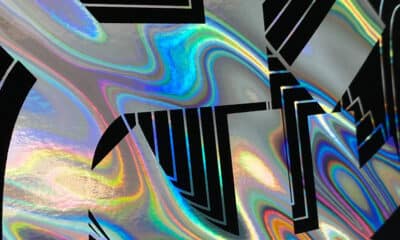Tips and How-To
Best of Both Worlds: Digital Hybrid and Variable Data Printing
The hybrid approach is designed to provide a digital enhancement to screen printing.
Published
5 years agoon

DIGITAL HYBRID PRINTING is a union between analog screen printing and digital direct-to-garment (DTG) printing, two of the most common embellishment technologies in use today. Essentially, a hybrid line consists of an automatic screen-printing press with a CMYK digital printer located on one of the print stations, with the ability to combine screen- and inkjet-printed graphics on each garment.
 DTG and screen printing each have their own unique strengths. DTG is capable of printing short-run quantities with minimal make ready, while screen printing offers rapid print speed with price-competitive consumables that make it the ideal choice for high-volume production. Additionally, with screen printing, any ink color and almost any fabric including polyester can be printed easily, and an unlimited range of special effects can be achieved.
DTG and screen printing each have their own unique strengths. DTG is capable of printing short-run quantities with minimal make ready, while screen printing offers rapid print speed with price-competitive consumables that make it the ideal choice for high-volume production. Additionally, with screen printing, any ink color and almost any fabric including polyester can be printed easily, and an unlimited range of special effects can be achieved.
The hybrid approach is designed to provide a digital enhancement to screen printing. Through the digital CMYK unit, users can decrease setup times and achieve image and color consistency. As with DTG, the printer can offer customers variable data options, but a unique advantage of hybrid is the endless number of customizations that can be created because of screen printing’s capabilities. Analog screen-print setups can be costly and time consuming, requiring high print volumes to absorb the expense. In today’s market, run sizes are trending smaller, requiring more efficiency to amortize setup. Hybrid printing harnesses the strength of both print technologies to create a unique capability for short- to medium-volume production.
What Makes Hybrid Unique?
Hybrid printing has a number of advantages over traditional DTG and screen printing. Color calibration systems in hybrid lines anticipate and assign CMYK builds to reproduce a gamut of color that includes most photorealistic images, but when a color is out of gamut, users add a screen to achieve it; additional stations on the press are open for special-effect applications that can’t be done via inkjet.
Hybrid printing is up to four times faster than traditional DTG. Using a screen-printed white underbase is faster and less than a quarter the cost of digital white. Hybrid is also versatile enough to handle any fabric that can be printed via traditional screen printing. Using migration blockers in the screen-printed underbase ink inhibits dye migration on polyester, allowing for a digital print on the surface.  These are all direct advantages over standard DTG. Compared to conventional screen printing, setups involve fewer and simpler tweaks to match customer specifications. This is because there are fewer screens to manage and the digital file can be updated with any changes instantly, creating less friction and allowing the printer to instantly resume printing.
These are all direct advantages over standard DTG. Compared to conventional screen printing, setups involve fewer and simpler tweaks to match customer specifications. This is because there are fewer screens to manage and the digital file can be updated with any changes instantly, creating less friction and allowing the printer to instantly resume printing.
One factor that makes digital hybrid printing so unique is its versatility with variable data orders. Variable data is a form of digital printing, including on-demand printing, in which elements such as text, graphics, and images may be changed from one printed piece to the next without stopping or slowing down production. New business models across the market actively use social media, analytics, and cloud-based management systems to collect in-depth data. Harnessing this information through a variable data strategy allows you to create customizations, get product to market faster, localize the supply chain, and lower the need for excess embellished inventory.
Four Business Models that Leverage Hybrid Printing
T-shirt subscription services are a perfect example of a variable data business model that can benefit from hybrid technology. A user signs up and receives an embellished garment every month. For example, a Chicago-themed service might deliver a different shirt each month decorated with a graphic or logo about the city. In a traditional model, most subscribers being of a similar demographic (i.e., from Chicago) would receive the same shirt. Add variable data into the mix and each patron could receive something unique. One subscriber may receive a shirt highlighting their favorite Chicago sports team, while another receives a garment focusing on the Great Lakes and fishing. Variable data draws from deep analytics on each individual member to allow for highly relevant customizations to be created.
Tourism is another market where variable data can be effectively used. You can represent large and small tourist markets with the same cost structure, tailoring runs to specific needs and reducing excess inventory. Name drops can contain actual image data relating to a specific location. Attractions can order multiple versions of a shirt highlighting the many aspects of the experience. For example, a local zoo could produce youth T-shirts with specific animals from the zoo, add a glow-in-the-dark effect for the nocturnal animals, and a UV effect for the diurnal. All of the zoo’s shirts could be produced in a single setup using a shared, screen-printed underbase with two special-effect screens (for the glow-in-the-dark and UV effects).
Music T-shirts produced for a specific concert or event are another example. Traditionally, official band merchandise depended on the popularity of a particular act, and producing location-specific designs was costly. Typically, designs incorporated the dates of the entire tour and were screen printed in volume. With digital hybrid technology, you can add 5 to 400 customized pieces for each location on the tour and sell them for a premium.
Finally, hybrid printing and variable data introduce a mass customization opportunity that has never existed before. It is now possible to produce hundreds of thousands of individualized shirts. Designs can carry a universal brand story with distinct image data, making them all singular to each market. You can go to a store in Los Angeles and find a shirt you love, fly to Chicago and find another; and not only will those two shirts be different, but every shirt, everywhere, will be an individual – just like the person wearing it.
AdvertisementFive Factors to Consider Before Adding Hybrid
First, consider run sizes. What are the complexity and lengths of your regular orders, whether screen or DTG? Hybrid fits well into a print model of 50 to 400 pieces – slightly longer runs than DTG, up to minimum cost effectiveness for screen print. Each technology has a sweet spot in cost effectiveness in which it will be the most advantageous to use for an order, although variable data could be a reason to disrupt this model because it makes each garment inherently more valuable. This means print runs longer than 400 pieces are achievable with hybrid, with the cost savings of screen printing balancing the higher costs of the digital. Using hybrid technology with long print runs is possible, with characteristics like variable data, high-resolution definition, screen reduction, and exact replication making longer runs not only possible, but also desirable.
Second, give some thought to how you’ll attract clients. Hybrid technology offers an unparalleled range of application possibilities, so thinking outside of the box is important. Special effects can be a great way to enhance and really promote this technology.
Third, plan to educate your existing clients about your new capabilities. Hybrid print resolution is high and sometimes this can mean a difference in image quality between screen print and hybrid output. This is a good issue to discuss with customers in advance. Making samples of a wide range of work is important for helping them understand the technology and its applications.
Fourth, consider workflow. With more digital application methods being used in our production facilities, automation, friction, and handling the data are key issues to address.
Creating metrics and using analytics internally gives you the best guide for streamlining your process. Hybrid will likely introduce a new data workflow that is more complex than traditional screen printing because it removes an analog workflow and replaces it with a digital one. Color calibration, for example, will be different. On the plus side, it involves less time mixing inks and making screens, yet there is definitely a learning curve for a traditional screen printer to adapt a digital workflow.
AdvertisementFinally, think about productivity. Hybrid is faster than DTG, but not as fast as screen printing: Like a true hybrid, it falls in the middle. It offers unique qualities that neither screen nor DTG can offer. Capitalizing on these aspects is the key to ultimately driving the success of hybrid printing in your shop.
Prepare for Change
The garment decoration industry is in the midst of a digital revolution. With more customization and data harnessing, digital is easily the answer for a fast-changing market. Hybrid technology brings the best of two worlds together, enhancing screen printing with variable data, reducing setups, and creating inventory control while improving DTG with special effects, precise color matching, and faster production speeds.
Michelle Moxley is a career research, development, and innovation expert, skilled in screen printing, special-effects printing, color separation, graphics, prepress, digital printing, and textiles. She is currently director of innovation at M&R. Follow her on Instagram @notoriousrandd.

SPONSORED VIDEO
Let’s Talk About It
Creating a More Diverse and Inclusive Screen Printing Industry
LET’S TALK About It: Part 3 discusses how four screen printers have employed people with disabilities, why you should consider doing the same, the resources that are available, and more. Watch the live webinar, held August 16, moderated by Adrienne Palmer, editor-in-chief, Screen Printing magazine, with panelists Ali Banholzer, Amber Massey, Ryan Moor, and Jed Seifert. The multi-part series is hosted exclusively by ROQ.US and U.N.I.T.E Together. Let’s Talk About It: Part 1 focused on Black, female screen printers and can be watched here; Part 2 focused on the LGBTQ+ community and can be watched here.
You may like
Advertisement

The Profit Impact of a Market Dominating Position

Inkcups Announces New CEO and Leadership Restructure

Hope Harbor to Receive Donation from BlueCotton’s 2024 Mary Ruth King Award Recipient
SUBSCRIBE

Bulletins
Get the most important news and business ideas from Screen Printing magazine's news bulletin.
Advertisement
Latest Feeds
Advertisement
Most Popular
-

 Case Studies2 months ago
Case Studies2 months agoHigh-Density Inks Help Specialty Printing Take Center Stage
-

 Art, Ad, or Alchemy2 months ago
Art, Ad, or Alchemy2 months agoF&I Printing Is Everywhere!
-

 Andy MacDougall2 months ago
Andy MacDougall2 months agoFunctional and Industrial Printing is EVERYWHERE!
-

 Columns3 weeks ago
Columns3 weeks ago8 Marketing Mistakes Not to Make When Promoting Your Screen Printing Services Online
-

 Editor's Note2 weeks ago
Editor's Note2 weeks agoLivin’ the High Life
-

 Marshall Atkinson2 weeks ago
Marshall Atkinson2 weeks agoHow to Create a Winning Culture in Your Screen-Printing Business
-

 Thomas Trimingham2 months ago
Thomas Trimingham2 months ago“Magic” Marketing for Screen Printing Shops
-

 News & Trends2 months ago
News & Trends2 months agoWhat Are ZALPHAS and How Can You Serve Them in Your Print Business?













